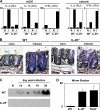Interleukin 25 regulates type 2 cytokine-dependent immunity and limits chronic inflammation in the gastrointestinal tract
- PMID: 16606667
- PMCID: PMC1800834
- DOI: 10.1084/jem.20051496
Interleukin 25 regulates type 2 cytokine-dependent immunity and limits chronic inflammation in the gastrointestinal tract
Abstract
The cytokine interleukin (IL) 25 has been implicated in the initiation of type 2 immunity by driving the expression of type 2 cytokines such as IL-5 and IL-13, although its role in the regulation of immunity and infection-induced inflammation is unknown. Here, we identify a dual function for IL-25: first, in promoting type 2 cytokine-dependent immunity to gastrointestinal helminth infection and, second, in limiting proinflammatory cytokine production and chronic intestinal inflammation. Treatment of genetically susceptible mice with exogenous IL-25 promoted type 2 cytokine responses and immunity to Trichuris. IL-25 was constitutively expressed by CD4+ and CD8+ T cells in the gut of mouse strains that are resistant to Trichuris, and IL-25-deficient mice on a genetically resistant background failed to develop a type 2 immune response or eradicate infection. Furthermore, chronically infected IL-25(-/-) mice developed severe infection-induced intestinal inflammation associated with heightened expression of interferon-gamma and IL-17, identifying a role for IL-25 in limiting pathologic inflammation at mucosal sites. Therefore, IL-25 is not only a critical mediator of type 2 immunity, but is also required for the regulation of inflammation in the gastrointestinal tract.
Figures





Comment in
-
Helper T cell differentiation enters a new era: le roi est mort; vive le roi!J Exp Med. 2006 Apr 17;203(4):809-12. doi: 10.1084/jem.20060522. Epub 2006 Apr 10. J Exp Med. 2006. PMID: 16606679 Free PMC article. Review.
References
-
- Murphy, K.M., and S.L. Reiner. 2002. The lineage decisions of helper T cells. Nat. Rev. Immunol. 2:933–944. - PubMed
-
- Mowen, K.A., and L.H. Glimcher. 2004. Signaling pathways in Th2 development. Immunol. Rev. 202:203–222. - PubMed
-
- Stetson, D.B., D. Voehringer, J.L. Grogan, M. Xu, R.L. Reinhardt, S. Scheu, B.L. Kelly, and R.M. Locksley. 2004. Th2 cells: orchestrating barrier immunity. Adv. Immunol. 83:163–189. - PubMed
-
- Cohn, L., J.A. Elias, and G.L. Chupp. 2004. Asthma: mechanisms of disease persistence and progression. Annu. Rev. Immunol. 22:789–815. - PubMed
-
- Umetsu, D.T., J.J. McIntire, O. Akbari, C. Macaubas, and R.H. DeKruyff. 2002. Asthma: an epidemic of dysregulated immunity. Nat. Immunol. 3:715–720. - PubMed
Publication types
MeSH terms
Substances
Grants and funding
LinkOut - more resources
Full Text Sources
Other Literature Sources
Molecular Biology Databases
Research Materials

